|
|
|
Sort Order |
|
|
|
Items / Page
|
|
|
|
|
|
|
| Srl | Item |
| 1 |
ID:
149889
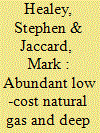

|
|
|
|
|
| Summary/Abstract |
This paper analyzes the implications of the natural gas revolution on the US’ ability to achieve deep GHG emissions reductions of 80% below 2005 levels by 2050. It uses a hybrid energy-economy model to test how prevailing low US natural gas prices influence the magnitude of the required carbon price needed to achieve this target. While the paper finds in general that lower gas prices resulting from plentiful gas necessitate a higher carbon price to achieve this target, informing firms and consumers in advance about the magnitude of the future carbon price can lower the necessary level.
|
|
|
|
|
|
|
|
|
|
|
|
|
|
|
|
| 2 |
ID:
033062


|
|
|
|
|
| Edition |
6th ed.
|
| Publication |
Essex, World of Information, 1981.
|
| Description |
407p.Hbk
|
| Standard Number |
0904439267
|
|
|
|
|
|
|
|
|
|
|
|
Copies: C:1/I:0,R:0,Q:0
Circulation
| Accession# | Call# | Current Location | Status | Policy | Location |
| 020514 | 909.9605/CAR 020514 | Main | On Shelf | General | |
|
|
|
|
| 3 |
ID:
150353


|
|
|
|
|
| Summary/Abstract |
China is vigorously promoting the development of its unconventional gas resources because natural gas is viewed as a lower-carbon energy source and because China has relatively little conventional natural gas supply. In this paper, we first evaluate how much unconventional gas might be available based on an analysis of technically recoverable resources for three types of unconventional gas resources: shale gas, coalbed methane and tight gas. We then develop three alternative scenarios of how this extraction might proceed, using the Geologic Resources Supply Demand Model. Based on our analysis, the medium scenario, which we would consider to be our best estimate, shows a resource peak of 176.1 billion cubic meters (bcm) in 2068. Depending on economic conditions and advance in extraction techniques, production could vary greatly from this. If economic conditions are adverse, unconventional natural gas production could perhaps be as low as 70.1 bcm, peaking in 2021. Under the extremely optimistic assumption that all of the resources that appear to be technologically available can actually be recovered, unconventional production could amount to as much as 469.7 bcm, with peak production in 2069. Even if this high scenario is achieved, China’s total gas production will only be sufficient to meet China’s lowest demand forecast. If production instead matches our best estimate, significant amounts of natural gas imports are likely to be needed.
|
|
|
|
|
|
|
|
|
|
|
|
|
|
|
|
| 4 |
ID:
126099
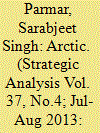

|
|
|
|
|
| Publication |
2013.
|
| Summary/Abstract |
Changes in the Arctic topography due to climate change have resulted in the region, which erstwhile was remote with little accessibility, to being accessible with potential natural resources and attractive navigable sea areas. The prospects have also influenced the strategic contours of the Arctic and brought in many actors that view the region as a resource-rich area with viable commercial interests. The Arctic attraction has gained significance as an economic goldmine with estimates indicating the region to hold about 22 per cent of the undiscovered, technically recoverable resources in the world. The approximate breakdown as per a US Geological Survey report is about 13 per cent of the undiscovered oil, 30 per cent of the undiscovered natural gas, and 20 per cent of the undiscovered natural gas liquids in the world. About 84 per cent of the estimated resources are expected to occur offshore.
|
|
|
|
|
|
|
|
|
|
|
|
|
|
|
|
| 5 |
ID:
127160


|
|
|
|
|
| Publication |
2014.
|
| Summary/Abstract |
Among natural gas producing nations, there has been some concern about how the Asia Pacific will meet future demand for energy. We argue that natural gas, both regional and global, will play a vital role. Estimates of potential gas consumption in the region are analyzed and used to develop consensus projections to 2030. These consumption profiles are compared with gas supply estimates including indigenous, pipeline and LNG for the Asia Pacific market. From this analytical framework, we find that demand will be sufficiently large to accommodate supplies from diverse sources including North America, the Middle East, Central Asia, Russia, and the Asia Pacific itself. An important policy implication is that gas producing and consuming nations should benefit from promoting gas trade and not be concerned about a situation of potential lack of demand coupled with oversupply.
|
|
|
|
|
|
|
|
|
|
|
|
|
|
|
|
| 6 |
ID:
123591


|
|
|
|
|
| Publication |
2013.
|
| Summary/Abstract |
We bring together a collection of papers that were presented at the inaugural event of the Asia-Europe Energy Policy Research Network (AEEPRN), held at Singapore in May 2012. The idea for creating AEEPRN was in response to the growing importance of energy in Asia and Europe's relations and to our shared belief that energy will become a more significant aspect of these relations over the forthcoming years and decades. The papers presented here cover the following themes: wind energy, biofuels, natural gas and gas pipelines, exergy and manufacturing, green energy co-operation, coal, unconventional gas and solar energy.
|
|
|
|
|
|
|
|
|
|
|
|
|
|
|
|
| 7 |
ID:
100703
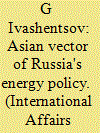

|
|
|
|
|
| Publication |
2010.
|
| Summary/Abstract |
IN NOVEMBER 2009, the Russian government approved The Russian Energy Strategy through 2030. In a situation where the struggle for energy resources has become probably the prime motive force of global politics, the path of development followed by the Russian energy industry in the next 20 years will to a very large degree predetermine the future of our country and its place in the system of international relations.
|
|
|
|
|
|
|
|
|
|
|
|
|
|
|
|
| 8 |
ID:
171377
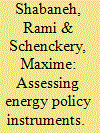

|
|
|
|
|
| Summary/Abstract |
Saudi Arabia relies heavily on oil-based generation to meet its power needs within a geographically unbalanced pattern of natural demand and supply. Many initiatives are currently being assessed to reduce the high opportunity cost of burning oil for the country. This paper examines the cost and implication of a disruptive policy where Saudi Arabia imports liquefied natural gas (LNG). To determine the possible and optimal sources to procure LNG into Saudi Arabia we use and configure a partial equilibrium model, specified as a linear programming problem. Two import scenarios were tested: the first assumes an import terminal with a capacity of 5 million tonnes per annum (MTPA) and the other scenario assumes 22 MTPA. Results show that Saudi Arabia can import LNG for power generation at a discount to the opportunity cost of oil. Especially during the summer months, as Saudi Arabia's gas demand is counter-seasonal to major importing regions it leads to even more interesting market pricing conditions. It also shows a small difference in landed cost of LNG between the two scenarios which implies the global LNG market can accommodate relatively large demand from Saudi Arabia without distorting significantly the global market pricing mechanism.
|
|
|
|
|
|
|
|
|
|
|
|
|
|
|
|
| 9 |
ID:
166302
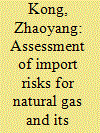

|
|
|
|
|
| Summary/Abstract |
China's growing dependence on foreign natural gas has garnered increased attention to import risks and exposure. The purpose of this study is to serve as a vital guide in formulating an energy policy framework that aims at assessing and mitigating the impacts of natural gas import risks (NGIR). First, the paper constructs a NGIR evaluation framework with full consideration of resource risk, political risk, transport risk, price volatility risk, purchasing power risk and dependence risk. The relative weight of various risk factors is also identified for importing gas from different sources. Building on this, we use a linear programming model to optimize China's gas import sources based on the minimization of import risks. The results show that China's NGIR exhibited increasing trends in 2010–2014, with variation in the largest risk factors by national gas supplier. For Turkmenistan and Indonesia, the greatest risk is dependence; for Qatar, price volatility risk; for Yemen, Australia and Uzbekistan, resource risk; and for Malaysia, purchasing power risk. Along with other policy recommendations, our optimization results indicate that increasing the proportion of Chinese gas imports from potential suppliers, such as Russia and the United States, is an effective approach to reduce NGIR.
|
|
|
|
|
|
|
|
|
|
|
|
|
|
|
|
| 10 |
ID:
127283
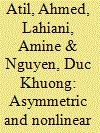

|
|
|
|
|
| Publication |
2014.
|
| Summary/Abstract |
In this article, we use the recently developed nonlinear autoregressive distributed lags (NARDL) model to examine the pass-through of crude oil prices into gasoline and natural gas prices. Our approach allows us to simultaneously test the short- and long-run nonlinearities through positive and negative partial sum decompositions of the predetermined explanatory variables. It also offers the possibility to quantify the respective responses of gasoline and natural gas prices to positive and negative oil price shocks from the asymmetric dynamic multipliers. The obtained results indicate that oil prices affect gasoline prices and natural gas prices in an asymmetric and nonlinear manner, but the price transmission mechanism is not the same. Important policy implications can be learned from the empirical findings.
|
|
|
|
|
|
|
|
|
|
|
|
|
|
|
|
| 11 |
ID:
176718
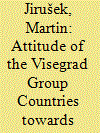

|
|
|
|
|
| Summary/Abstract |
The article analyses individual stances of the Visegrad Group countries (i.e. Czech Republic, Slovakia, Poland and Hungary) towards infrastructural projects in the natural gas sector currently being built by Gazprom, and determining factors influencing their respective attitudes. More specifically, the research focused on Nord Stream 2 and TurkStream, pipelines that aim at supplying Europe while circumventing traditional transit countries in the central and Eastern Europe, including the Visegrad group countries. The paper is organized as a series of individual case studies, each dedicated to one state under scrutiny. The author concluded that there is no common ground upon which a unified stance of the Visegrad Group could be formulated in this regard. Also, the states differ in adherence to theoretical attitudes to energy policy in general. Despite the declared unity, the Visegrad Group states pursue their own goals determined by economic interests or long-standing foreign policy stance. Consequently, central Europe is fragmented in its attitude towards the Russian infrastructural projects and thus more prone to penetration and individualized deals.
|
|
|
|
|
|
|
|
|
|
|
|
|
|
|
|
| 12 |
ID:
094858


|
|
|
|
|
| Publication |
2010.
|
| Summary/Abstract |
The need to find cleaner, safer and less expensive sources of fuel in the city of Manaus, capital of the state of Amazonas (AM) in Brazil is inevitable due, among other factors, to the historical situation of the petroleum-derived fuel's large-scale use for power generation in the city by Brazil's energy planning. In this context, the use of natural gas in the province of Urucu, in the city of Coari countryside of the state of Amazons, is the best short-term solution, which will enable the substitution of petroleum-derived liquid fuels for the natural gas in the thermoelectric power plants in the city of Manaus and in seven other cities in the state, which are favored by the Coari-Manaus pipeline's main trajectory. This article presents the economic and environmental benefits with gas natural introduction in the energy matrix of isolated electrical system in Manaus. This project will be a great conquest for the city of Manaus, as a result of the Brazilian Energy Sector 20-year-planning, which will be completed in 2010, and will permit the beginning of a new growth-and-development cycle for the state of Amazonas and the Amazon itself.
|
|
|
|
|
|
|
|
|
|
|
|
|
|
|
|
| 13 |
ID:
123669


|
|
|
|
|
| Publication |
2013.
|
| Summary/Abstract |
This article considers the political-economic process by which "energy angst" created an embedded nuclear orientation in Japanese energy policymaking, and then how, following Fukushima, Japan initially tried to transform that structural tendency, through a political system poorly suited to reform, before edging back toward its traditional path. Due both to the prevailing systemic bias and the underlying political economy of nuclear power, the process of transformation promises to be a turbulent and extended one, with natural gas and energy efficiency being crucial tools for ameliorating the difficult realities of the domestic status quo.
|
|
|
|
|
|
|
|
|
|
|
|
|
|
|
|
| 14 |
ID:
106297
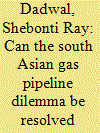

|
|
|
| 15 |
ID:
133182
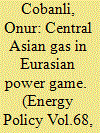

|
|
|
|
|
| Publication |
2014.
|
| Summary/Abstract |
Following the dissolution of the Soviet Union, various gas pipeline projects have been proposed to diversify transit routes and export markets of the landlocked Central Asian states. To evaluate the pipeline project's impact on the players' bargaining power, I apply the cooperate game theory to a quantitative model of the Eurasian gas trade and quantify the bargaining power structure via the Shapley value. Due to ample production capacities in Central Asia, I observe little strategic interaction between the West and China. Thus, demand competition with China is not necessarily a disadvantage for the West, and the Turkmenistan-China pipeline does not affect the impact of the westbound projects aiming Europe and Turkey. For Turkmenistan, i.e., the main supplier in the region, a link via the Caspian Sea to Turkey is the most beneficial westbound option. Although the projects carrying gas from Azerbaijan and Turkmenistan to Europe enjoy the European Commission's political support, they yield marginal benefits to the European consumers. Thanks to its transit position, Turkey collects a large share of the benefits in the East-West gas trade.
|
|
|
|
|
|
|
|
|
|
|
|
|
|
|
|
| 16 |
ID:
140841
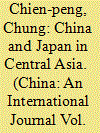

|
|
|
|
|
| Summary/Abstract |
Central Asia is a region where both China and Japan would like to pursue greater roles and interests. Largely initiated by China, the Shanghai Cooperation Organisation has enhanced China’s influence in Central Asia. This has caused concern for Japan, which then sought to expand its presence in the region. Through meetings and dialogues with Central Asian leaders, and by providing aid and loans to states in the region, leaders of China and Japan have been trying to obtain contracts for extracting oil, natural gas, rare metals, uranium and other minerals from Central Asian states, and secure peace in Afghanistan.
|
|
|
|
|
|
|
|
|
|
|
|
|
|
|
|
| 17 |
ID:
098974
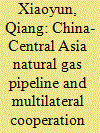

|
|
|
| 18 |
ID:
132627


|
|
|
|
|
| Publication |
2014.
|
| Summary/Abstract |
Within the last twenty years, China has become dependent on import of coal, oil and natural gas. Especially oil is now an economic and a security concern by the Chinese regime and key international stakeholders. Until 2035, China will account for one fourth of the global net growth in global gas consumption and more than half of the net growth in oil consumption. The future demand cannot be covered by China×s own conventional and unconventional sources. Pipelines from neighboring countries can cover more than half of the needed import of natural gas by 2030, but only 10 percent of the import demand of oil is secured so far. Even if China attempts to address its insufficient supply of oil by increased investments in overseas oil fields, there is still a large gap. Furthermore, the oil import will largely come from politically unstable countries and regions, and the bulk of the supplies must be shipped through the potentially insecure Hormuz and Malacca Straits. The ongoing territorial disputes with neighboring countries regarding areas with gas and oil reserves in contested waters bear evidence to regional conflict potentials, and China appears to engage more actively in energy diplomacy and regional cooperation.
|
|
|
|
|
|
|
|
|
|
|
|
|
|
|
|
| 19 |
ID:
127279
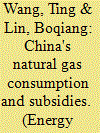

|
|
|
|
|
| Publication |
2014.
|
| Summary/Abstract |
China's natural gas consumption is growing rapidly and it has being driven by economic growth, industrialization and urbanization. In addition, the country's low-carbon development strategy, government-controlled gas price, and some other factors also contribute to the surging gas consumption. This paper studies China's natural gas consumption in residential, industrial and commercial sectors. We adopt the cointegration test and error correction model to study the relationships of explanatory factors and gas consumption of different sectors and climate factor is included into the analysis. In order to find the direction of natural gas pricing reform and establish the benchmark gas price, this paper also estimates the size of gas price subsidy by using price-gap approach. Our findings are as follows: In the long term, China's residential sector is more sensitive to price than the other two. Urbanization is an important factor promoting industrial and commercial gas consumption. Prices of other energies have an influence on natural gas consumption significantly due to the substitutability between energies. The slow-moving and unsatisfying pricing reforms on refined oil and natural gas lead to positive price elasticity of natural gas in the commercial sector, which implies that a further energy price reform is still stringent for China.
|
|
|
|
|
|
|
|
|
|
|
|
|
|
|
|
| 20 |
ID:
113427
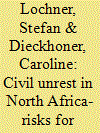

|
|
|
|
|
| Publication |
2012.
|
| Summary/Abstract |
The uprising and military confrontation in Libya that began in February 2011 has led to disruptions of gas supplies to Europe. An analysis of how Europe has compensated for these missing gas volumes shows that this situation has not affected security of supply. However, this situation would change if the North African uprising were to spread to Algeria. Since Algeria is a much more important gas supplier to Europe than is Libya, more severe consequences would be likely. Applying a natural gas infrastructure model, we investigate the impact of supplier disruptions from both countries for a summer and winter period. Our analysis shows that disruptions in the low-demand summer months could be compensated for, mainly by LNG imports into several European countries. An investigation of a similar situation at the beginning of the winter shows that security of supply would be severely compromised and that disruptions to Italian consumers would be unavoidable. The analysis thereby highlights the importance of taking the political stability of supply countries into account when assessing the security of European gas imports.
|
|
|
|
|
|
|
|
|
|
|
|
|
|
|
|
|
|
|
|
|